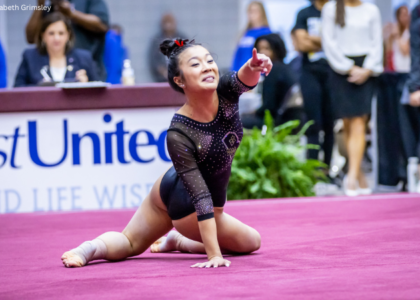It’s time again to look at which teams made the largest jumps (and dropped the farthest) in the rankings between 2020 and 2021. Like last year, we looked at which teams improved the most in their overall ranking and which conferences improved the most on average. But unlike last year, we are doing a few things differently to account for the new way NQS was calculated for 2021 due to the pandemic. Instead of looking at which teams improved the most by NQS, we looked at which teams improved the most by average from 2020 to 2021.
Largest Rankings Changes
Like last year, we made some adjustments to account for there being no postseason in 2020. Instead of comparing the final rankings from 2020 to the final rankings from 2021, we instead compared the final rankings from 2020 to the final regular season rankings from 2021. This also accounts for the fact that two teams who qualified to regionals—Auburn and Temple—were unable to compete due to COVID protocols, so the 2021 regular season ranking shows a better picture of their overall seasons than their final 2021 ranking. Only teams that had enough scores for an NQS were included.
Division II teams are in blue, Division III teams are in red and USAG teams are italicized.
The two teams with the biggest jumps in the rankings were Towson and Temple, which moved up 20 spots and 17 spots, respectively. Both teams had record-breaking seasons in 2021 and both qualified to regionals for the first time in over 20 years. Another notable jump was from Boise State, which bounced back from a rough 2020 season to move up 16 spots in 2021.
Largest Changes in Average
Because of the COVID-19 pandemic and the potential of a shortened season in 2021, the NCAA change the way it calculated NQS, only averaging the top four scores (with at least two away) instead of the typical way NQS has been in the past. Because of this, it wasn’t fair to compare NQS from 2020 to that of 2021. That’s where average comes in. For some teams, the change in average gives a better picture.
Note: A few teams had meets where they did not have enough routines for a full team score. These scores were removed from the average for our purposes.
As seen in the graph above, generally an increase in average leads to an increase in ranking and vice versa. The most notable outlier on the graph is Centenary, which moved up 11 spots in the rankings despite its average going down 0.686. This is almost entirely due to so many teams opting out of the 2021 season. Because there were fewer teams, Centenary finished higher in the rankings, so the average gives a much better picture of its season overall.
Division II teams are in blue, Division III teams are in red and USAG teams are italicized. Teams that had scores thrown out are denoted with an asterisk(*).
The team with the largest change in average was Gustavus Adolphus, which went up by nearly one and a half points from 2020 to 2021. It is important to note that the Gusties only had four meets in 2021, but they had an excellent season overall despite the circumstances.
The two teams with the largest change in ranking, Towson and Temple, also had some of the largest changes in average, coming in at No. 2 and No. 4, respectively. Also improving its average significantly was Iowa, which improved its average by over a point despite only moving up six spots in the rankings.
Largest Changes by Conference
The last thing we looked at was the average difference in ranking and average difference in average for each conference.
| Conference | Average Difference in Ranking | Average Difference in Average |
| Big 12 | -1.500 | -0.269 |
| Big Ten | +0.111 | +0.021 |
| EAGL | +1.286 | +0.195 |
| ECAC-I | N/A | -2.396 |
| MAC | +7.000 | +0.199 |
| MIC | +7.800 | +0.338 |
| MPSF | +2.500 | -0.226 |
| MRGC | +7.000 | +0.388 |
| Pac 12 | -8.875 | -0.672 |
| SEC | -2.500 | +0.078 |
| WIAC | N/A | -1.150 |
Note: Temple made the switch from ECAC-I to EAGL for the 2021 season and is included in the EAGL averages.
The conference that had the largest increase in ranking was the MIC. This is helped out by the fact that many teams opted out of 2021, as every MIC team moved up in the rankings. However, the MIC also had the second highest increase in average, so the large ranking change is not as misleading as it might initially seem.
Other conferences with significant increases in ranking and average were the MRGC and the MAC. They were both tied for second in ranking difference, moving up seven spots on average. The MRGC had the largest improvement in average (+0.388) while the MAC came in third (+0.199).
Article by Mary Emma Burton
Like what you see? Consider donating to support our efforts throughout the year!




